The Stop-Start-Continue feedback method is a powerful tool for enhancing leadership effectiveness. This framework helps leaders identify actions to stop, start, and continue to improve their performance and team dynamics.
In this article, we will learn how to implement the Stop-Start-Continue template effectively and explore examples of positive feedback for leaders. Moreover, we will discover how this method can be used in performance reviews and transition seamlessly from "continue" to "start" for enhanced productivity. So, are you ready? Let's unlock the potential of this simple yet impactful feedback strategy to drive continuous improvement and success in your leadership journey.
What is the Stop-Start-Continue Framework
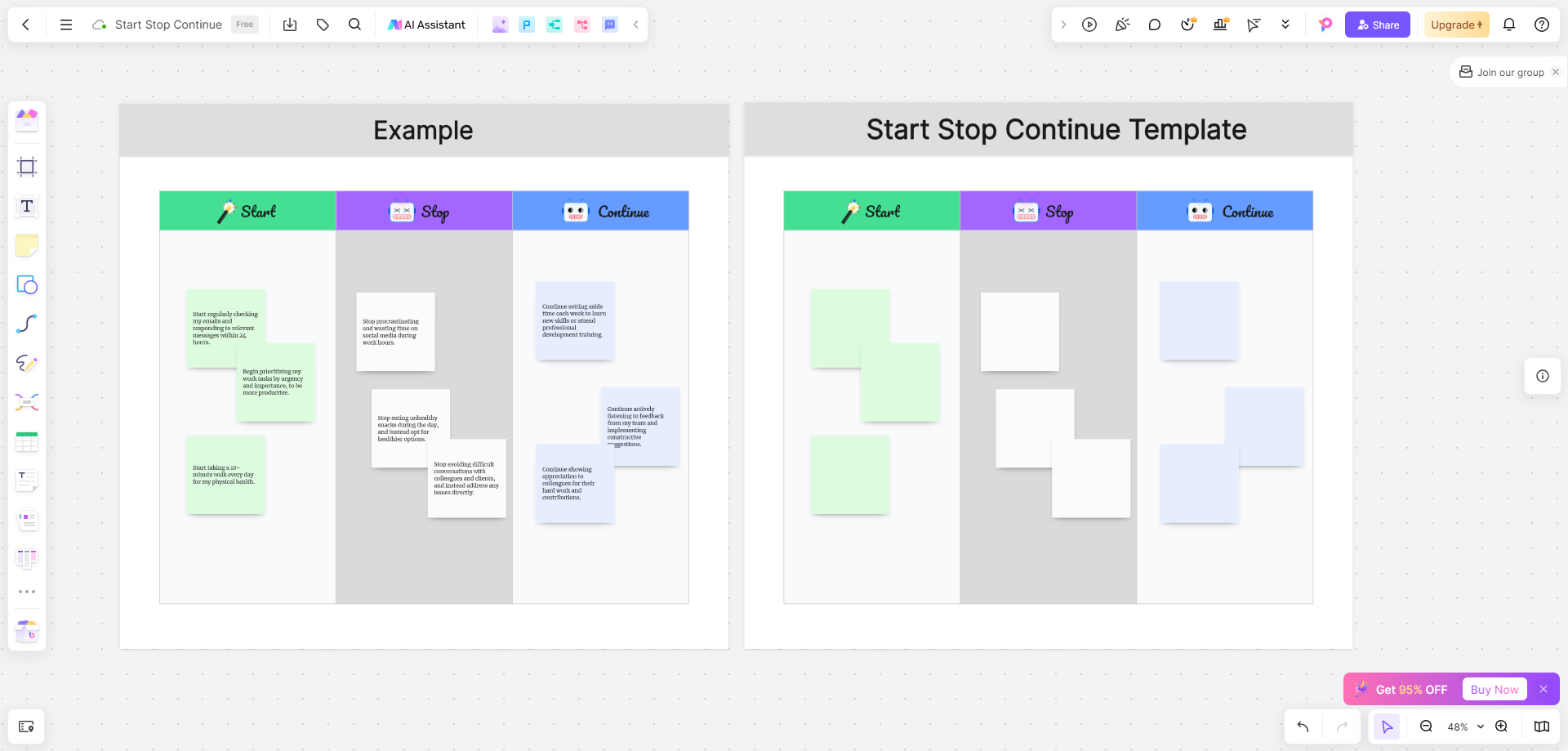
The Stop Start Continue framework, also known as the Start Stop Continue template, is a well-established model for delivering constructive feedback and driving continuous improvement. It's a simple and straightforward tool, yet highly effective and versatile. Here's everything you need to know about this popular framework:
The Structure of the Stop-Start-Continue Framework
3 Key Pillars of the Stop-Start-Continue Framework
1. Stop: Identify behaviors, actions, or practices that are impeding progress or causing issues. These are elements that you should stop doing.
2. Start: Highlight new initiatives, strategies, or behaviors that should be introduced to boost performance or achieve desired outcomes. These are things you should start doing.
3. Continue: Point out actions or practices that are working well and contributing positively towards your goals. These are elements that should continue.
This approach ensures that feedback is well-rounded and comprehensive, covering all aspects of performance and practices.
Application Scenarios of the Stop-Start-Continue Framework
The versatility of the Stop-Start-Continue framework allows it to be used in various scenarios, including:
1. Personal Development: Individuals can use this method for self-assessment, determining what habits they need to stop, what new behaviors they should start, and what practices they must continue to grow and improve.
2. Performance Reviews: Managers can utilize this framework to provide clear, actionable feedback to their team members, helping them understand where they excel and where they need to improve.
3. Team Evaluation: Teams can use this tool to reflect on their collective practices, identify areas of improvement, and recognize successful strategies.
4. Organizational Strategy: Businesses can implement this framework for strategic planning, identifying which strategies should be discontinued, which new approaches to try, and which successful strategies should be maintained.
By understanding and implementing the Stop-Start-Continue framework, you can foster an environment of constructive feedback, drive meaningful improvements, and steer continuous growth in personal and professional contexts.
How to Implement the Stop-Start-Continue Template Effectively

Implementing the Stop-Start-Continue template effectively can bring about substantial improvements in performance, efficiency, and overall productivity.
Get Downloadable and Editable Stop-Start-Continue Templates
For a practical start, you can find downloadable and editable versions of the Stop-Start-Continue template on Boardmix. You can edit it online and then download it once you finish. Here are the steps:
1.Login to Boardmix.
2.Start from a new board.
3.Search for Stop-Start-Continue in the Template library.
4.Use it and edit it online.
5.Share it for collaboration.
6.Export and download it for other demonstrations.
Designing the Stop-Start-Continue Template
The template is divided into three main columns or sections:
1. Stop: This section is used to list down behaviors, actions, or practices that aren't yielding desired results or causing problems. These elements are to be discontinued or altered.
2. Start: In this section, new actions, behaviors, or strategies that need to be adopted are listed. These could be innovative solutions or necessary changes that can help achieve desired goals.
3. Continue: This section includes successful practices that are already being followed and should be continued for continued positive outcomes.
Each section should have ample space to write down detailed points. It is also beneficial to include a 'Notes' or 'Action Steps' area next to each point to jot down specific plans or further reflections.
Using the Stop-Start-Continue Template

1. Identify Key Elements: Start by reflecting on your current practices and strategies. Identify which ones are ineffective (stop), which ones could prove beneficial if introduced (start), and which ones are yielding good results (continue).
2. Fill Out the Template: Once you've identified these elements, start filling out the template accordingly. Be specific and actionable in your points. Instead of writing vague statements, break down actions into feasible steps.
3. Prioritize Actions: After filling out the template, prioritize the points in each section based on their urgency and potential impact. This prioritization will guide you on which actions to focus on first.
4. Plan Implementation: In the 'Notes' or 'Action Steps' area, jot down specific plans for implementing the points listed in the 'Start' section, altering the ones in 'Stop', and maintaining the ones in 'Continue'.
5. Review Regularly: This template isn't a one-time tool; it should be reviewed and updated regularly to reflect any changes in your strategies or outcomes.
Stop-Start-Continue Examples: Positive Feedback for Leaders
Providing positive feedback for leaders is essential for fostering a culture of growth and improvement. Utilizing the Stop-Start-Continue method allows for clear, actionable feedback that directly impacts a leader's performance and team's trust. Here are some Stop-Start-Continue examples of positive feedback for leaders.
Positive Feedback Using the Stop-Start-Continue Method
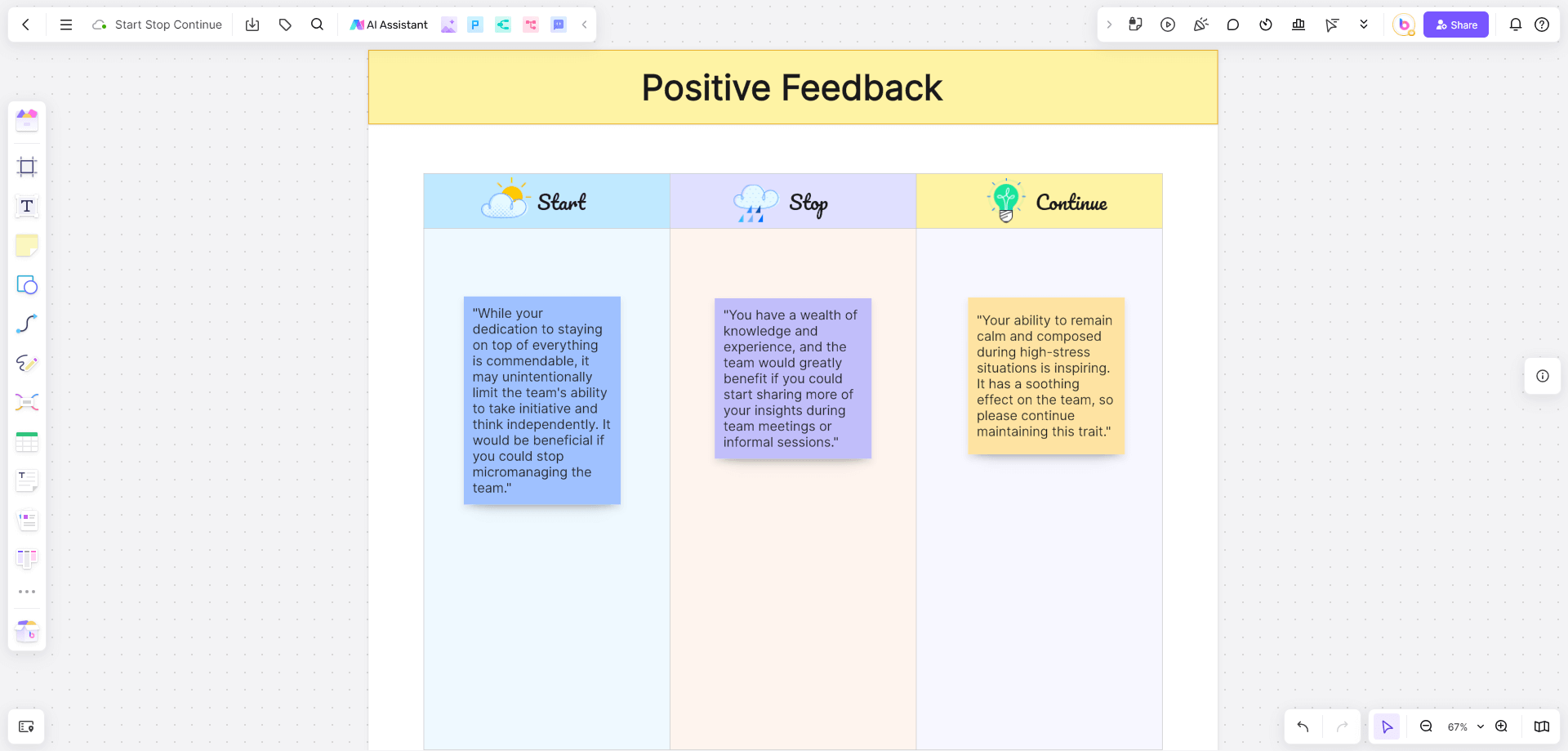
1. Stop: "While your dedication to staying on top of everything is commendable, it may unintentionally limit the team's ability to take initiative and think independently. It would be beneficial if you could stop micromanaging the team."
2. Start: "You have a wealth of knowledge and experience, and the team would greatly benefit if you could start sharing more of your insights during team meetings or informal sessions."
3. Continue: "Your ability to remain calm and composed during high-stress situations is inspiring. It has a soothing effect on the team, so please continue maintaining this trait."
Practical Leadership Feedback Examples
1. For a leader who's good at strategic planning
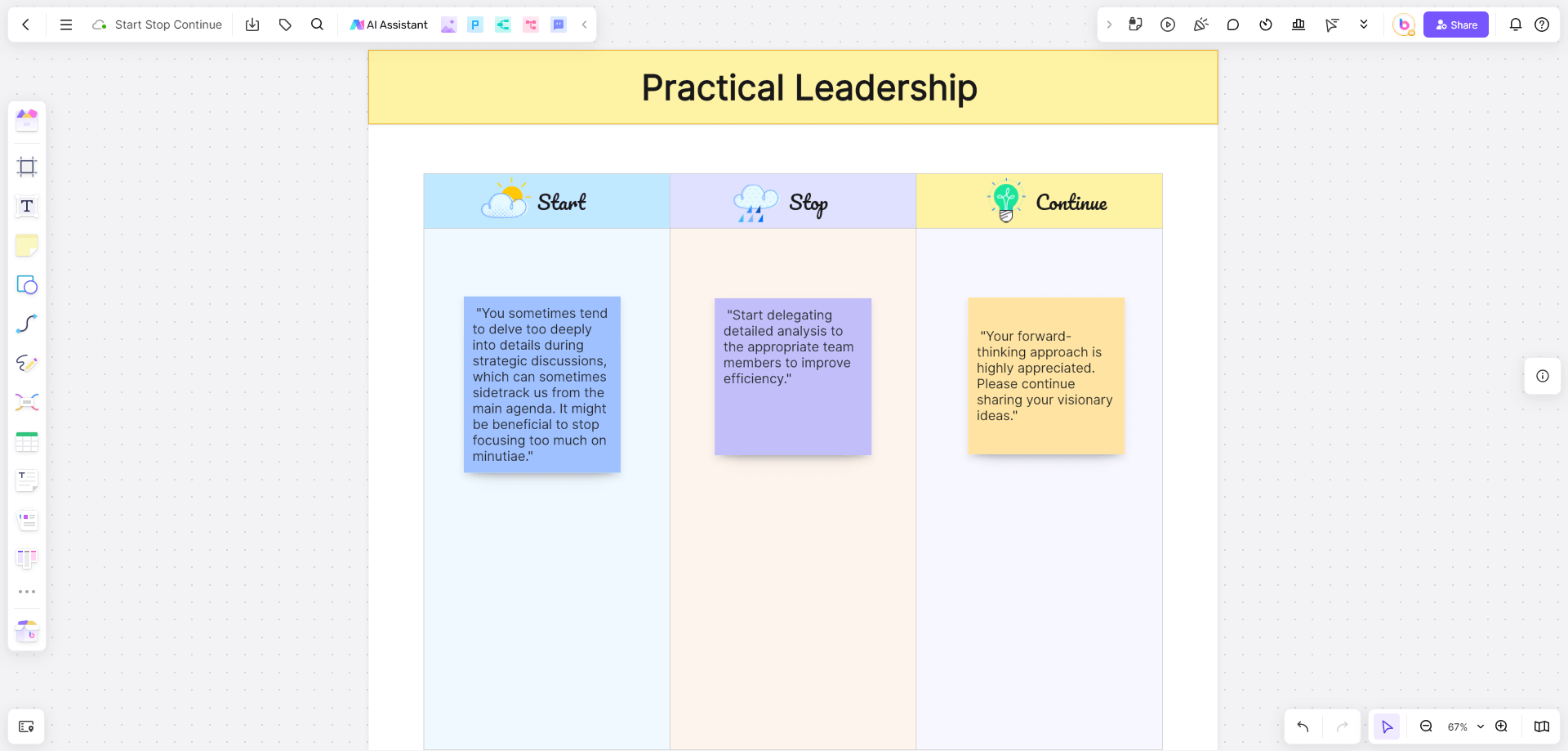
Stop: "You sometimes tend to delve too deeply into details during strategic discussions, which can sometimes sidetrack us from the main agenda. It might be beneficial to stop focusing too much on minutiae."
Start: "Start delegating detailed analysis to the appropriate team members to improve efficiency."
Continue: "Your forward-thinking approach is highly appreciated. Please continue sharing your visionary ideas."
2. For a leader who's an effective communicator
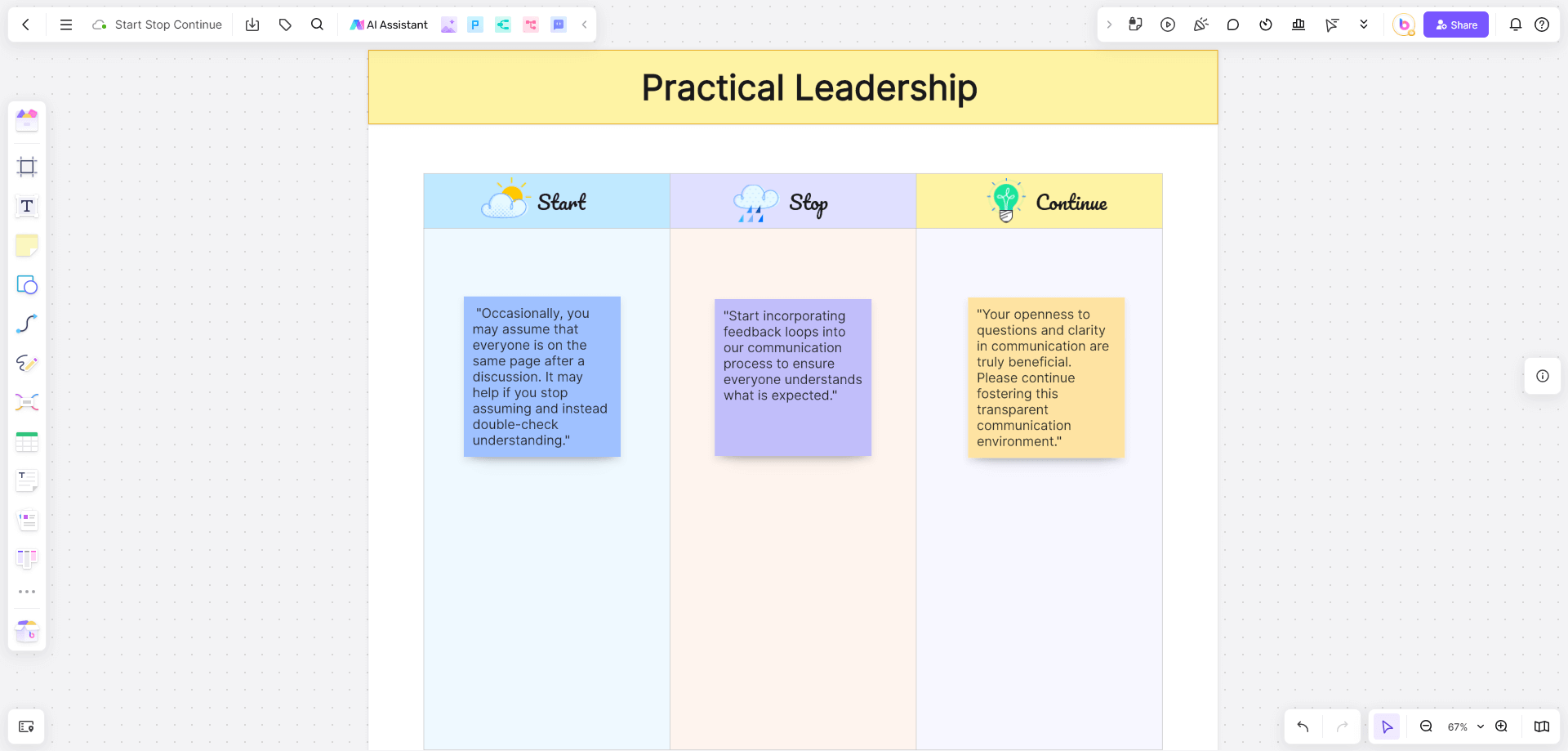
Stop: "Occasionally, you may assume that everyone is on the same page after a discussion. It may help if you stop assuming and instead double-check understanding."
Start: "Start incorporating feedback loops into our communication process to ensure everyone understands what is expected."
Continue: "Your openness to questions and clarity in communication are truly beneficial. Please continue fostering this transparent communication environment."
3. For a leader who excels at problem-solving

Stop: "Sometimes, you tend to take charge of problem-solving yourself, which may stifle the team's ability to learn and grow. It might be better to stop solving all issues by yourself."
Start: "Start involving team members in brainstorming and decision-making processes to develop their problem-solving skills."
Continue: "Your knack for identifying potential issues before they escalate is remarkable. Please continue this proactive approach."
Giving feedback using the Stop-Start-Continue method can significantly boost a leader's performance by clearly highlighting the actions that they need to stop, start, and continue. When done positively and constructively, it can foster better relationships within the team and enhance overall productivity.
Examples of Stop-Start-Continue in Performance Reviews
The Stop-Start-Continue method is a popular tool for performance reviews. It encourages clear, actionable feedback and aids in mapping out development paths for employees. Here are some examples and best practices for using this framework in performance reviews.
Performance Review Using the Stop-Start-Continue Method
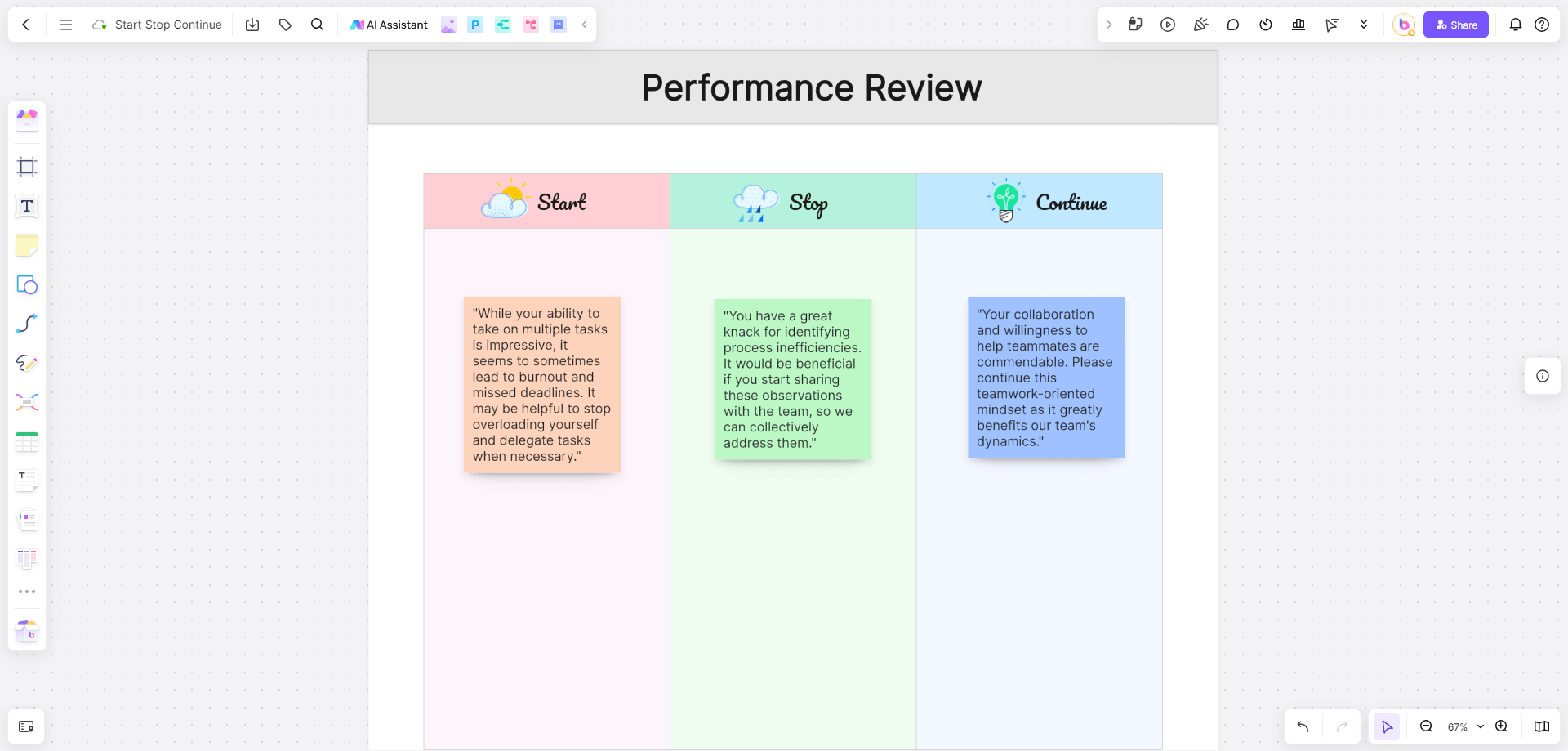
1. Stop: "While your ability to take on multiple tasks is impressive, it seems to sometimes lead to burnout and missed deadlines. It may be helpful to stop overloading yourself and delegate tasks when necessary."
2. Start: "You have a great knack for identifying process inefficiencies. It would be beneficial if you start sharing these observations with the team, so we can collectively address them."
3. Continue: "Your collaboration and willingness to help teammates are commendable. Please continue this teamwork-oriented mindset as it greatly benefits our team's dynamics."
Practical Performance Review Examples
1. For an employee who's a team player
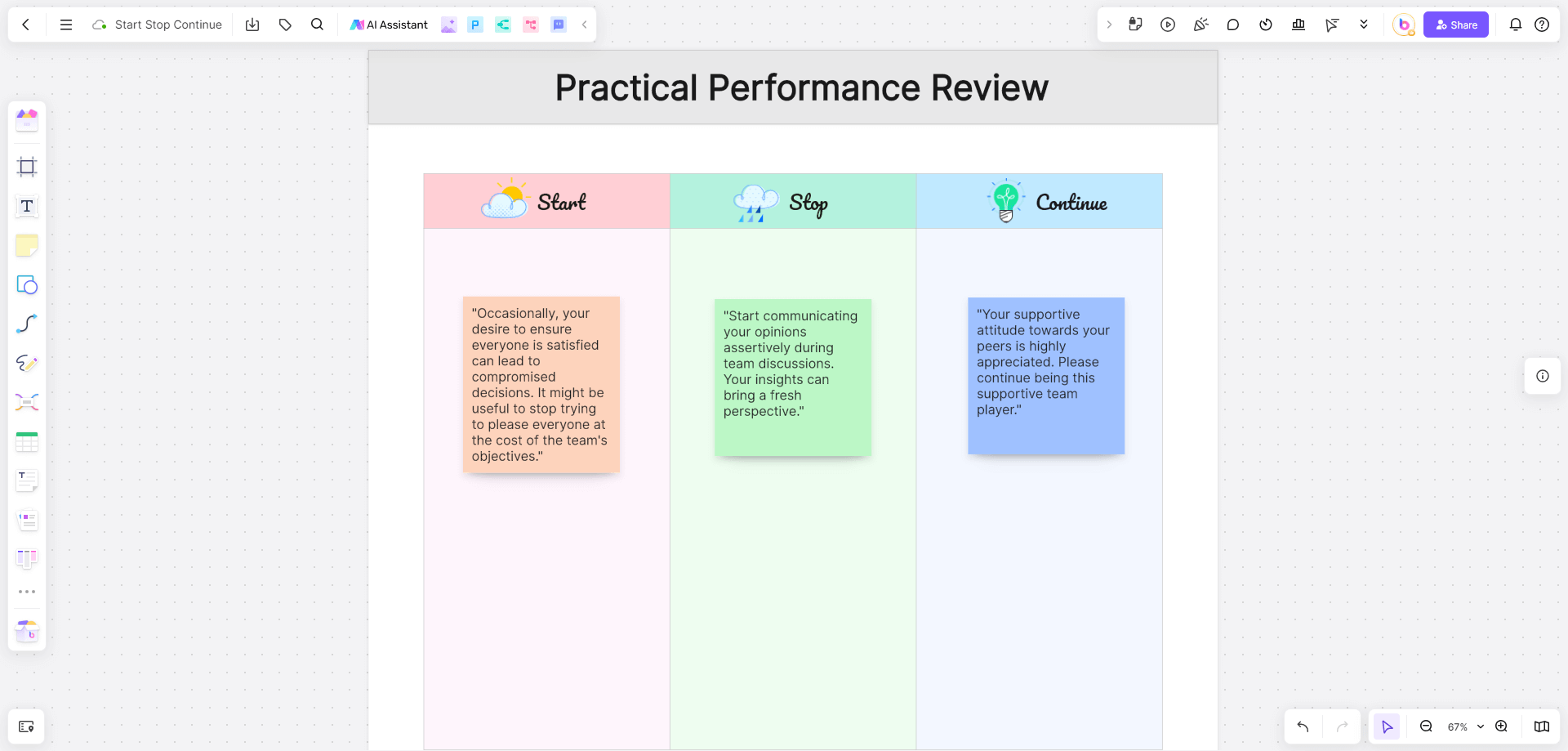
Stop: "Occasionally, your desire to ensure everyone is satisfied can lead to compromised decisions. It might be useful to stop trying to please everyone at the cost of the team's objectives."
Start: "Start communicating your opinions assertively during team discussions. Your insights can bring a fresh perspective."
Continue: "Your supportive attitude towards your peers is highly appreciated. Please continue being this supportive team player."
2. For an employee who's good at innovation
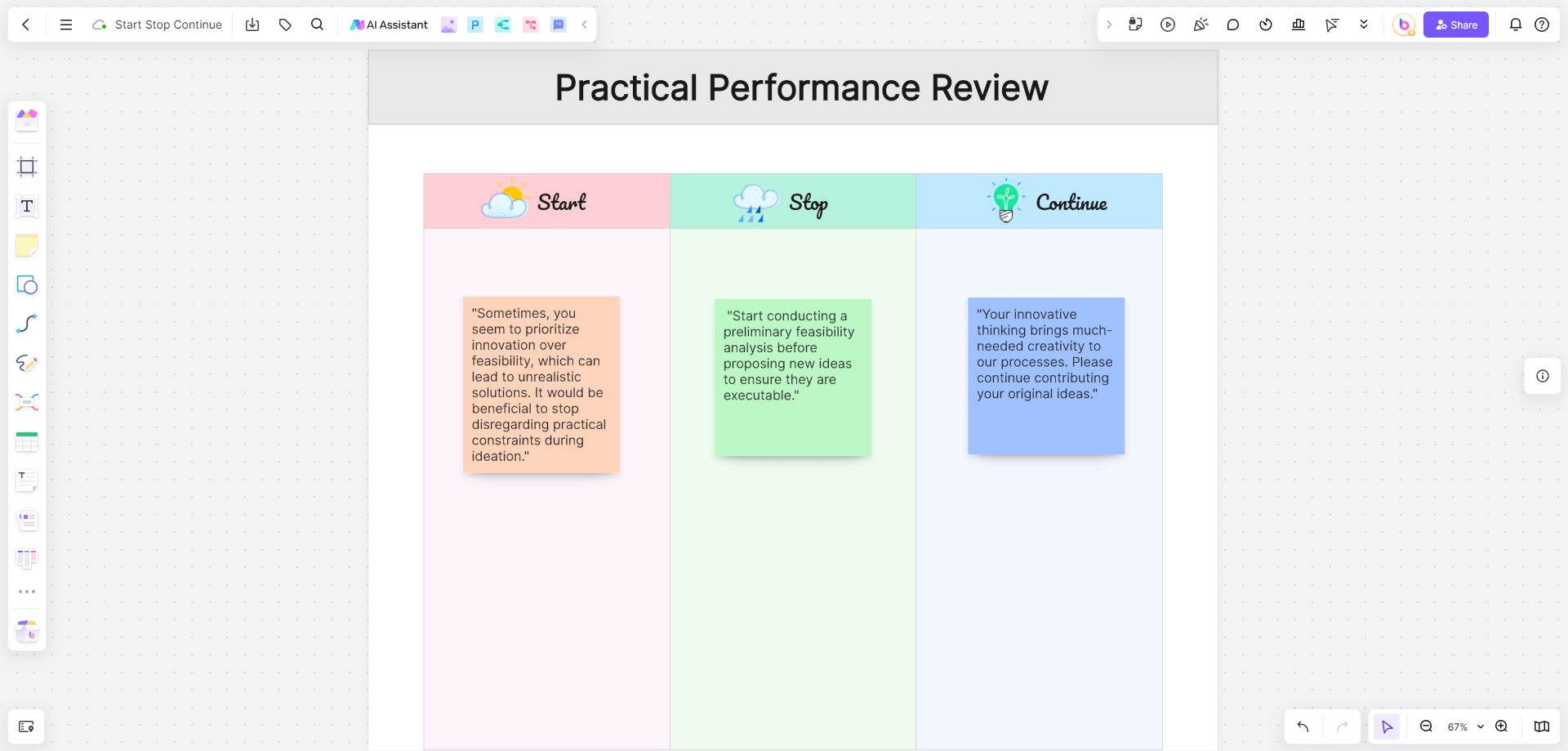
Stop: "Sometimes, you seem to prioritize innovation over feasibility, which can lead to unrealistic solutions. It would be beneficial to stop disregarding practical constraints during ideation."
Start: "Start conducting a preliminary feasibility analysis before proposing new ideas to ensure they are executable."
Continue: "Your innovative thinking brings much-needed creativity to our processes. Please continue contributing your original ideas."
3. For an employee who excels at client interaction

Stop: "At times, your eagerness to satisfy clients may make you overcommit. It might help to stop promising more than what can be reasonably delivered."
Start: "Start setting clear expectations with clients right from the beginning to avoid misunderstandings down the line."
Continue: "Your friendly and professional demeanor with clients is greatly appreciated. Please continue maintaining these excellent client relations."
Using the Stop-Start-Continue method in performance reviews encourages clear feedback and actionable development plans, helping employees understand how they can improve their performance. This, in turn, promotes personal growth, job satisfaction, and increased productivity.
How to Transition from Continue to Start for Enhanced Productivity
After learning so many examples of using the Stop-Start-Continue method, now we move into the most difficult part--making the shift from 'continue' to 'start'. How do we identify activities that need to make this transition, and what are some effective ways to implement this change? That's what we are going to delve into.

Identifying Activities for Transition
1. Repeatedly Faced Issues: If you continually encounter challenges in certain areas, it may be time to switch those activities from 'continue' to 'start'. It means you need to approach these areas with a fresh mindset or a new strategy.
2. Unmet Goals: If there are objectives that persistently remain unachieved despite ongoing efforts, these goals might need to be moved from the 'continue' column to 'start', signifying a need for an innovative solution or a different way of working.
3. Feedback: Regular feedback from team members or stakeholders can provide valuable insights into what isn't working and needs to be addressed with a fresh approach.
Successful Transition Case Studies and Tips
1. Microsoft's transition from Windows to Cloud Computing: Despite being synonymous with PC operating systems, Microsoft identified the need for a shift towards cloud computing in response to changing technology trends and user demands. This 'start' action led to the birth of Microsoft Azure, one of the leading cloud service platforms today.
2. Lego's transition to themed playsets: Once struggling due to an inability to compete with digital entertainment, Lego made a successful transition from 'continue' (producing traditional block sets) to 'start' (introducing themed playsets and digital games). This shift revolutionized their product line and re-established Lego as a beloved brand.
Remember, transitioning from 'continue' to 'start' doesn't always mean discarding old practices. Sometimes, it simply means adapting them or adopting new ones for enhanced productivity.
Conclusion
Mastering the Stop-Start-Continue feedback method can significantly enhance your leadership, providing clear, actionable insights for continuous improvement. Real-world examples in leadership and performance reviews showcase their positive impact on productivity and development.
In Boardmix Whiteboard, leaders can not only easily create and update "Stop-Start-Continue" templates to evaluate project feedback, but also centralize project management in a shared and collaborative space. Try Boardmix Whiteboard now, use the "Stop-Start-Continue" template for free, and improve your leadership skills!









